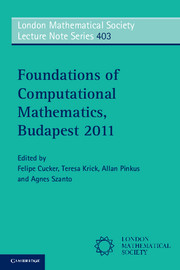Book contents
- Frontmatter
- Contents
- Preface
- Contributors
- 1 The State of the Art in Smale's 7th Problem
- 2 The Shape of Data
- 3 Upwinding in Finite Element Systems of Differential Forms
- 4 On the Complexity of Computing Quadrature Formulas for SDEs
- 5 The Quantum Walk of F. Riesz
- 6 Modulated Fourier Expansions for Continuous and Discrete Oscillatory Systems
- 7 The Dual Role of Convection in 3D Navier-Stokes Equations
- 8 Algebraic and Differential Invariants
- 9 Through the Kaleidoscope: Symmetries, Groups and Chebyshev-Approximations from a Computational Point of View
- 10 Sage: Creating a Viable Free Open Source Alternative to Magma, Maple, Mathematica, and MATLAB
- References
8 - Algebraic and Differential Invariants
Published online by Cambridge University Press: 05 December 2012
- Frontmatter
- Contents
- Preface
- Contributors
- 1 The State of the Art in Smale's 7th Problem
- 2 The Shape of Data
- 3 Upwinding in Finite Element Systems of Differential Forms
- 4 On the Complexity of Computing Quadrature Formulas for SDEs
- 5 The Quantum Walk of F. Riesz
- 6 Modulated Fourier Expansions for Continuous and Discrete Oscillatory Systems
- 7 The Dual Role of Convection in 3D Navier-Stokes Equations
- 8 Algebraic and Differential Invariants
- 9 Through the Kaleidoscope: Symmetries, Groups and Chebyshev-Approximations from a Computational Point of View
- 10 Sage: Creating a Viable Free Open Source Alternative to Magma, Maple, Mathematica, and MATLAB
- References
Summary
Abstract
This article highlights a coherent series of algorithmic tools to compute and work with algebraic and differential invariants.
Introduction
Group actions are ubiquitous in mathematics and arise in diverse fields of science and engineering, including physics, mechanics, and computer vision. Invariants of these group actions typically arise to reduce a problem or to decide if two objects, geometric or abstract, are obtained from one another by the action of a group element. [8, 9, 10, 11, 13, 15, 17, 39, 40, 42, 43, 45, 46, 52, 59] are a few recent references of applications. Both algebraic and differential invariant theories have become in recent years the subject of computational mathematics [13, 14, 17, 40, 60]. Algebraic invariant theory studies polynomial or rational invariants of algebraic group actions [18, 22, 23, 54]. A typical example is the discriminant of a quadratic binary form as an invariant of an action of the special linear group. The differential invariants appearing in differential geometry are smooth functions on a jet bundle that are invariant under a prolonged action of a Lie group [4, 16, 34, 48, 53]. A typical example is the curvature of a plane curve, invariant under the action of the group of the isometries on the plane. Curvature is not a rational function, but an algebraic function. Concomitantly the classical Lie groups are linear algebraic groups.
This article reviews results of [14, 28, 29, 30, 31, 32] in order to show their coherence in addressing algorithmically an algebraic description of the differential invariants of a group action. In the first section we show how to compute the rational invariants of a group action and give concrete expressions to a set of algebraic invariants that are of fundamental importance in the differential context. The second section addresses the question of finite representation of differential invariants with invariant derivations, a set of generating differential invariants and the differential relationships among them. In the last section we describe the algebraic structure that better serves the representation of differential invariants.
- Type
- Chapter
- Information
- Foundations of Computational Mathematics, Budapest 2011 , pp. 165 - 187Publisher: Cambridge University PressPrint publication year: 2012



